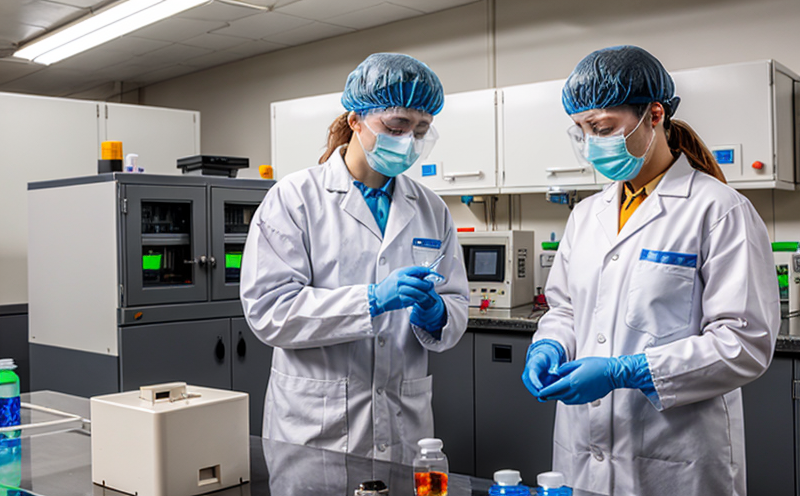EN 18266 3-MCPD Quantification in Infant Foods
The European Standard EN 18266 specifies a method for quantifying 3-monochloropropane-1,2-diol (3-MCPD) in infant foods. This standard is crucial as it addresses the presence of compounds that can be harmful to infants and young children if consumed in significant quantities over time. Infant formulas, baby meals, and other products intended for this age group are particularly vulnerable due to their developing systems.
The quantification of 3-MCPD in infant foods is important because 3-MCPD is a chloropropanol compound that can form during the processing or storage of certain food ingredients. It has been identified as potentially harmful to human health, especially when consumed by infants and young children who are more susceptible to its adverse effects due to their smaller body mass and still-developing organs.
The standard provides detailed instructions for sample preparation, extraction methods, instrumental analysis using high-performance liquid chromatography (HPLC), and the calculation of 3-MCPD concentrations. The methodology ensures accurate quantification while accounting for matrix interferences that might otherwise distort results.
For quality managers and compliance officers overseeing infant food production, understanding EN 18266 is essential to ensure product safety and regulatory compliance. By adhering to this standard, manufacturers can demonstrate their commitment to producing safe and compliant products, which in turn protects public health and builds consumer trust.
R&D engineers involved in the development of new formulas or processes for infant foods will benefit from knowledge of EN 18266 as it provides a robust framework for testing. This ensures that any new ingredients or processing methods are evaluated against stringent criteria, minimizing the risk of introducing harmful compounds into the final product.
Procurement officers must also consider this standard when selecting suppliers and ingredients. Ensuring that all incoming materials comply with EN 18266 helps to maintain a high level of quality throughout the supply chain, thereby safeguarding infant health.
The quantification process outlined in EN 18266 involves several steps: sample preparation, extraction, clean-up, and analysis. Sample preparation typically includes homogenization or blending of the food matrix to ensure uniformity. Extraction methods use solvents like methanol or acetonitrile to dissolve target compounds from the sample into a solution suitable for HPLC analysis.
After extraction, the sample undergoes clean-up steps such as solid-phase extraction (SPE) or liquid-liquid partitioning to remove interfering components before final analysis. HPLC equipped with UV detection is used to separate and quantify 3-MCPD in the sample matrix. Calibration curves are generated using standard solutions of known concentrations of 3-MCPD, allowing for accurate quantification.
Accurate quantification of 3-MCPD is critical because even low levels can accumulate over time, leading to potential health risks. Regulatory limits set by standards like EN 18266 help to mitigate these risks by establishing safe upper thresholds for 3-MCPD in infant foods.
The standard also emphasizes the importance of quality assurance throughout the testing process, including proper calibration of instruments and regular verification of analytical methods. This ensures consistent and reliable results that can be relied upon for regulatory submissions and internal quality control.
By following EN 18266, laboratories and manufacturers can provide consumers with confidence in the safety and quality of infant foods, knowing they meet stringent international standards designed to protect public health.
Applied Standards
| Standard Reference | Description | Scope |
|---|---|---|
| EN 18266:2015 | Method for Quantification of 3-Monochloropropane-1,2-Diol (3-MCPD) in Infant Foods | Detailed methodological guidelines for quantifying 3-MCPD in infant foods. |
| ISO 6579:2014 | Guidelines on the Use of Chromatographic Techniques in Food Analysis | Provides general guidance on the use of chromatography, including HPLC, for food analysis. |
Why Choose This Test
- Ensures compliance with international standards and regulatory requirements.
- Protects infant health by quantifying harmful compounds in foods.
- Maintains brand reputation through consistent quality assurance practices.
- Aids in the development of safer, more nutritious products for infants.
- Provides reliable data for regulatory submissions and internal audits.
- Enhances supply chain transparency and traceability.
International Acceptance and Recognition
- The standard is widely recognized by food safety authorities across Europe and globally, ensuring broad acceptance.
- It aligns with other international standards such as ISO 6579 for chromatographic techniques in food analysis.
- Compliance with EN 18266 can facilitate market access to countries that require adherence to European standards.





